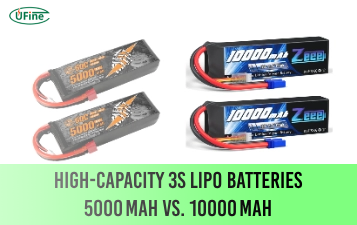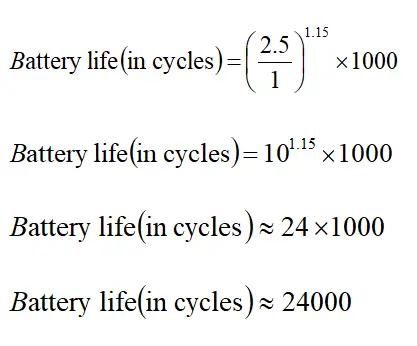How to increase 18650 lithium-ion battery life? Keeping these batteries working well for our devices like laptops and electric cars. They need special care to live a long time. This guide tells you simple ways to care for them so they work better for longer. Let’s learn how to make our 18650 batteries last longer!
Part 1. How do you prolong the life of an 18650 lithium-ion battery?
Charging Practices
- Optimal Charging: Utilize chargers designed explicitly for 18650 batteries and adhere to manufacturer guidelines. Avoid leaving batteries connected to chargers for extended periods post-full charge.
- Intelligent Chargers: Invest in smart chargers that monitor and regulate charging cycles, preventing overcharging and optimizing battery health.
- Avoid Overcharging: Unplug the charger once the battery reaches total capacity to prevent overcharging, which can degrade battery health.
- Maintain Optimal Voltage: To preserve longevity, keep batteries within their recommended voltage range during charging and usage.
18650 Battery Storage
- Temperature Control: Store batteries in environments with moderate temperatures, ideally between 20°C to 25°C (68°F to 77°F). Extreme temperatures, both hot and cold, can negatively impact battery health.
- Partial Charging for Storage: If storing batteries for an extended duration, maintain them at around 50% charge. Avoid storing fully charged or fully depleted batteries.
Usage
- Avoid Deep Discharges: Refrain from completely draining the battery before recharging. Partial discharges put less stress on the battery and contribute to a longer lifespan.
- Rotate Usage: If employing multiple 18650 batteries, rotate their usage to ensure even wear and tear across all batteries.
- Optimize Device Settings: Adjust device settings to minimize battery drain. Lower brightness, turn off unnecessary background apps and disable features when not in use to conserve battery power.
Regular Maintenance
- Cleaning Procedures: Periodically clean the battery terminals using a dry cloth to remove dust or residue that may hinder proper connections.
- Check for Physical Damage: Inspect batteries for signs of physical damage or swelling. Damaged batteries should be replaced promptly to avoid safety hazards.
Avoid Extreme Conditions
- Heat and Cold Precautions: Avoid exposing batteries to extreme temperatures, as high heat and freezing temperatures can impair battery performance and lifespan.
Part 2. Factors affecting 18650 battery life
Temperature Extremes
- Heat Impact: Exposure to high temperatures accelerates chemical reactions within the battery, leading to degradation and a shortened lifespan.
- Cold Conditions: Similarly, extreme cold slows down chemical reactions, reducing the battery’s efficiency and capacity.
Charge Cycles
- Cycle Count: The Number of charge-discharge cycles directly affects battery life. Each cycle contributes to a gradual reduction in overall capacity.
- Depth of Discharge: Deeper discharges, persistent ones, hasten the deterioration of the battery’s overall health.
Overcharging and Over-Discharging
- Overcharging Risks: Continuous overcharging can lead to increased heat generation, damaging the battery’s internal structure and reducing its lifespan.
- Over-Discharging Impact: Allowing the battery to discharge too much may cause irreversible damage, impacting its capacity to hold a charge.
Storage Conditions
- Temperature and Humidity: Storing batteries in extreme or high humidity environments can accelerate self-discharge and chemical breakdown.
- State of Charge: Prolonged storage at full charge or near empty levels can lead to capacity loss and chemical instability.
Usage Patterns
- High-Drain Applications: Batteries used in high-drain devices or applications that draw excessive current experience accelerated wear and reduced lifespan.
- Improper Handling: Physical damage, such as dropping or mishandling batteries, can compromise their internal structure, impacting longevity.
Quality of Manufacturing
- Quality Control: Variations in manufacturing processes and materials can affect the consistency of batteries’ overall quality and performance.
- Authenticity and Brand: Counterfeit or low-quality batteries often have inferior components, leading to quicker degradation.
Environmental Factors
- Chemical Exposure: Exposure to corrosive substances or chemicals can lead to internal corrosion, compromising battery integrity.
- Vibration and Mechanical Stress: Excessive vibration or mechanical stress can damage internal components, reducing battery life.
Part 3. How to calculate 18650 battery cycle life?
Definition of Cycle Life
The cycle life of a battery refers to the Number of complete charge and discharge cycles it can endure before its capacity diminishes to a specified level, typically around 80% of its original capacity.
Calculating 18650 Battery Cycle Life
1. Using Peukert Equation
The Peukert equation calculates the adequate capacity of a battery at different discharge rates. The formula is:
Battery Life = Number of cycles before reaching a specified end-of-life capacity
Battery Capacity
Battery Capacity = Nominal capacity of the battery (measured in Ampere-hours, Ah)
Discharge Current
Discharge Current = Rate at which the battery is discharged (measured in Amperes, A)
k = Peukert’s exponent (specific to the battery chemistry and discharge rate)
Constant = A constant determined experimentally
2. Example Calculation
Consider an 18650 battery with a nominal capacity of 2500mAh (or 2.5Ah) and a discharge rate of 1A. Suppose the Peukert exponent for this battery is approximately 1.15, and the constant is determined experimentally as 1000.
Using the Peukert equation:
This calculation suggests that, under these specific conditions, the 18650 battery might endure around 24,000 cycles before reaching the specified end-of-life capacity.
3. Variations and Real-World Considerations
- Different Discharge Rates: The battery’s cycle life will vary at different discharge rates due to the Peukert effect.
- Temperature and Environmental Factors: Extreme temperatures or environmental stressors might impact the battery’s performance and alter the calculated cycle life.
- Actual Usage Patterns: Real-world usage might differ from ideal conditions, impacting the battery’s cycle life. Monitoring the battery’s health over time is crucial for accurate predictions.
Part 4. FAQs
-
How long do 18650 batteries last?
Factors like usage, charging habits, and environmental conditions determine the lifespan of an 18650 battery. Typically, they last around 2 to 5 years or 300 to 500 charge cycles before experiencing notable capacity degradation. -
How many times can an 18650 battery be recharged?
An 18650 battery can generally be recharged between 300 to 500 cycles before experiencing significant capacity loss. However, this Number can vary based on charging practices and battery quality. -
Can you overcharge 18650 batteries?
Overcharging 18650 batteries can lead to safety hazards like overheating, gas venting, or even fires. Using a charger with overcharge protection or avoiding prolonged charging after the battery reaches total capacity is essential. -
When should I replace my 18650 battery?
Consider replacing your 18650 battery when it shows signs of significantly reduced capacity or reduced runtime or when it no longer holds a charge as it did when new. Damaged or degraded batteries should be replaced for safety reasons.
Related Tags:
More Articles

High‑Capacity 3S LiPo Batteries: 5000 mAh vs. 10000 mAh
Compare 3S LiPo 5000mAh vs 10000mAh batteries by weight, power, and use. Find the best fit for your drone, RC car, or boat setup.
Top 5 Applications for Small 3S LiPo Batteries
Small 3S LiPo batteries power drones, RC gear, wearables, and robotics with high energy and low weight. Making them ideal for compact electronics projects.
Building and Charging Your Own 3S LiPo Pack: A Step‑by‑Step Guide
Learn how to build, balance, and charge a 3S LiPo battery pack safely at home with this complete DIY guide for hobbyists and beginners.
How to Choose the Right LiPo Battery Plug Type?
Discover the best LiPo battery plug types, how to choose them, and expert tips for safe usage, soldering, and maintenance.
Choosing the Right Connector for Your 3S LiPo Battery
Choosing the right 3S LiPo connector depends on current, space, and use. Learn the pros and cons of XT60, JST, EC3, and more.






